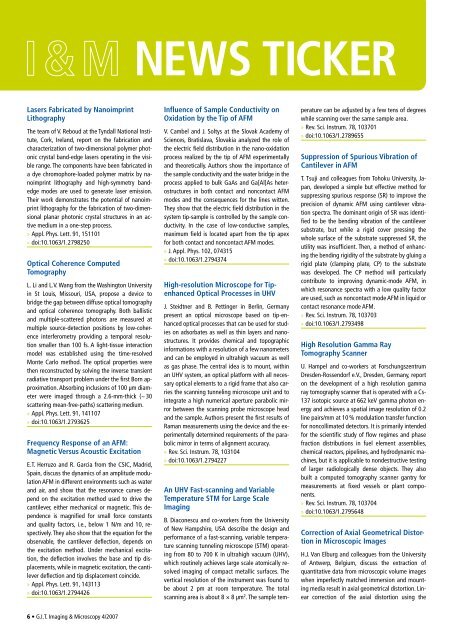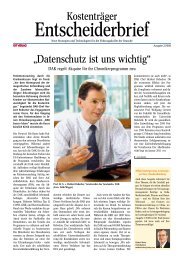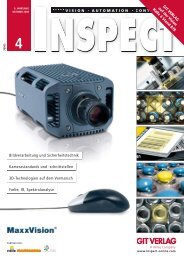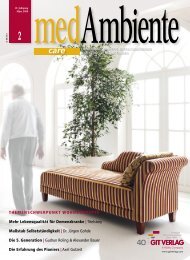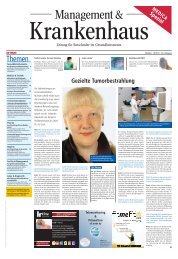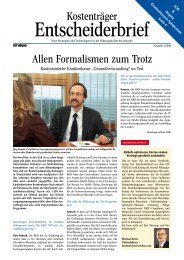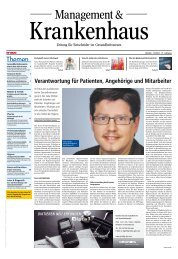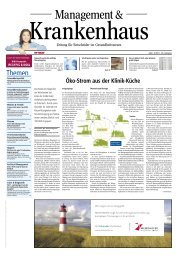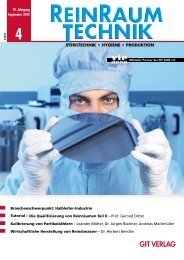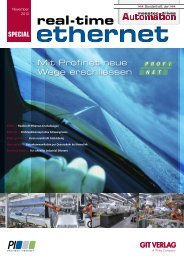Huge Images? - GIT Verlag
Huge Images? - GIT Verlag
Huge Images? - GIT Verlag
You also want an ePaper? Increase the reach of your titles
YUMPU automatically turns print PDFs into web optimized ePapers that Google loves.
Lasers Fabricated by Nanoimprint<br />
Lithography<br />
The team of V. Reboud at the Tyndall National Institute,<br />
Cork, Ireland, report on the fabrication and<br />
characterization of two-dimensional polymer photonic<br />
crystal band-edge lasers operating in the visible<br />
range. The components have been fabricated in<br />
a dye chromophore-loaded polymer matrix by nanoimprint<br />
lithography and high-symmetry bandedge<br />
modes are used to generate laser emission.<br />
Their work demonstrates the potential of nanoimprint<br />
lithography for the fabrication of two-dimensional<br />
planar photonic crystal structures in an active<br />
medium in a one-step process.<br />
» Appl. Phys. Lett. 91, 151101<br />
» doi:10.1063/1.2798250<br />
Optical Coherence Computed<br />
Tomography<br />
L. Li and L.V. Wang from the Washington University<br />
in St Louis, Missouri, USA, propose a device to<br />
bridge the gap between diffuse optical tomography<br />
and optical coherence tomography. Both ballistic<br />
and multiple-scattered photons are measured at<br />
multiple source-detection positions by low-coherence<br />
interferometry providing a temporal resolution<br />
smaller than 100 fs. A light-tissue interaction<br />
model was established using the time-resolved<br />
Monte Carlo method. The optical properties were<br />
then reconstructed by solving the inverse transient<br />
radiative transport problem under the first Born approximation.<br />
Absorbing inclusions of 100 µm diameter<br />
were imaged through a 2.6-mm-thick (~ 30<br />
scattering mean-free-paths) scattering medium.<br />
» Appl. Phys. Lett. 91, 141107<br />
» doi:10.1063/1.2793625<br />
Frequency Response of an AFM:<br />
Magnetic Versus Acoustic Excitation<br />
E.T. Herruzo and R. Garcia from the CSIC, Madrid,<br />
Spain, discuss the dynamics of an amplitude modulation<br />
AFM in different environments such as water<br />
and air, and show that the resonance curves depend<br />
on the excitation method used to drive the<br />
cantilever, either mechanical or magnetic. This dependence<br />
is magnified for small force constants<br />
and quality factors, i.e., below 1 N/m and 10, respectively.<br />
They also show that the equation for the<br />
observable, the cantilever deflection, depends on<br />
the excitation method. Under mechanical excitation,<br />
the deflection involves the base and tip displacements,<br />
while in magnetic excitation, the cantilever<br />
deflection and tip displacement coincide.<br />
» Appl. Phys. Lett. 91, 143113<br />
» doi:10.1063/1.2794426<br />
• G.I.T. Imaging & Microscopy 4/2007<br />
NEwS TICkER<br />
Influence of Sample Conductivity on<br />
Oxidation by the Tip of AFM<br />
V. Cambel and J. Soltys at the Slovak Academy of<br />
Sciences, Bratislava, Slovakia analyzed the role of<br />
the electric field distribution in the nano-oxidation<br />
process realized by the tip of AFM experimentally<br />
and theoretically. Authors show the importance of<br />
the sample conductivity and the water bridge in the<br />
process applied to bulk GaAs and Ga[Al]As heterostructures<br />
in both contact and noncontact AFM<br />
modes and the consequences for the lines witten.<br />
They show that the electric field distribution in the<br />
system tip-sample is controlled by the sample conductivity.<br />
In the case of low-conductive samples,<br />
maximum field is located apart from the tip apex<br />
for both contact and noncontact AFM modes.<br />
» J. Appl. Phys. 102, 074315<br />
» doi:10.1063/1.2794374<br />
High-resolution Microscope for Tipenhanced<br />
Optical Processes in UHV<br />
J. Steidtner and B. Pettinger in Berlin, Germany<br />
present an optical microscope based on tip-enhanced<br />
optical processes that can be used for studies<br />
on adsorbates as well as thin layers and nanostructures.<br />
It provides chemical and topographic<br />
informations with a resolution of a few nanometers<br />
and can be employed in ultrahigh vacuum as well<br />
as gas phase. The central idea is to mount, within<br />
an UHV system, an optical platform with all necessary<br />
optical elements to a rigid frame that also carries<br />
the scanning tunneling microscope unit and to<br />
integrate a high numerical aperture parabolic mirror<br />
between the scanning probe microscope head<br />
and the sample. Authors present the first results of<br />
Raman measurements using the device and the experimentally<br />
determined requirements of the parabolic<br />
mirror in terms of alignment accuracy.<br />
» Rev. Sci. Instrum. 78, 103104<br />
» doi:10.1063/1.2794227<br />
An UHV Fast-scanning and Variable<br />
Temperature STM for Large Scale<br />
Imaging<br />
B. Diaconescu and co-workers from the University<br />
of New Hampshire, USA describe the design and<br />
performance of a fast-scanning, variable temperature<br />
scanning tunneling microscope (STM) operating<br />
from 80 to 700 K in ultrahigh vacuum (UHV),<br />
which routinely achieves large scale atomically resolved<br />
imaging of compact metallic surfaces. The<br />
vertical resolution of the instrument was found to<br />
be about 2 pm at room temperature. The total<br />
scanning area is about 8 × 8 µm 2 . The sample tem-<br />
perature can be adjusted by a few tens of degrees<br />
while scanning over the same sample area.<br />
» Rev. Sci. Instrum. 78, 103701<br />
» doi:10.1063/1.2789655<br />
Suppression of Spurious Vibration of<br />
Cantilever in AFM<br />
T. Tsuji and colleagues from Tohoku University, Japan,<br />
developed a simple but effective method for<br />
suppressing spurious response (SR) to improve the<br />
precision of dynamic AFM using cantilever vibration<br />
spectra. The dominant origin of SR was identified<br />
to be the bending vibration of the cantilever<br />
substrate, but while a rigid cover pressing the<br />
whole surface of the substrate suppressed SR, the<br />
utility was insufficient. Then, a method of enhancing<br />
the bending rigidity of the substrate by gluing a<br />
rigid plate (clamping plate, CP) to the substrate<br />
was developed. The CP method will particularly<br />
contribute to improving dynamic-mode AFM, in<br />
which resonance spectra with a low quality factor<br />
are used, such as noncontact mode AFM in liquid or<br />
contact resonance mode AFM.<br />
» Rev. Sci. Instrum. 78, 103703<br />
» doi:10.1063/1.2793498<br />
High Resolution Gamma Ray<br />
Tomography Scanner<br />
U. Hampel and co-workers at Forschungszentrum<br />
Dresden-Rossendorf e.V., Dresden, Germany, report<br />
on the development of a high resolution gamma<br />
ray tomography scanner that is operated with a Cs-<br />
137 isotopic source at 662 keV gamma photon energy<br />
and achieves a spatial image resolution of 0.2<br />
line pairs/mm at 10 % modulation transfer function<br />
for noncollimated detectors. It is primarily intended<br />
for the scientific study of flow regimes and phase<br />
fraction distributions in fuel element assemblies,<br />
chemical reactors, pipelines, and hydrodynamic machines,<br />
but it is applicable to nondestructive testing<br />
of larger radiologically dense objects. They also<br />
built a computed tomography scanner gantry for<br />
measurements at fixed vessels or plant components.<br />
» Rev. Sci. Instrum. 78, 103704<br />
» doi:10.1063/1.2795648<br />
Correction of Axial Geometrical Distortion<br />
in Microscopic <strong>Images</strong><br />
H.J. Van Elburg and colleagues from the University<br />
of Antwerp, Belgium, discuss the extraction of<br />
quantitative data from microscopic volume images<br />
when imperfectly matched immersion and mounting<br />
media result in axial geometrical distortion. Linear<br />
correction of the axial distortion using the


